#sicilian history
Explore tagged Tumblr posts
Text





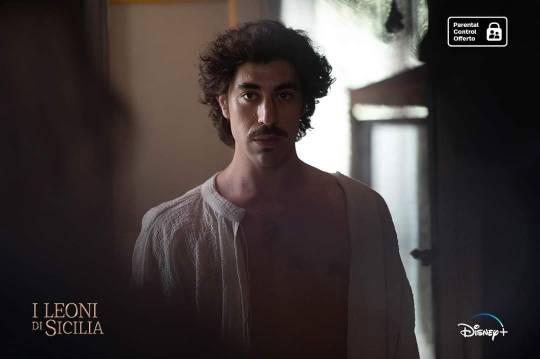
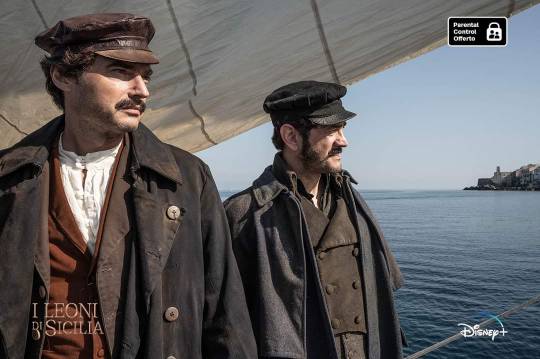


I can't wait 🥰
Fonte
#disney plus#The Florios of sicily#The Florios family#Sicily#history#Sicilian history#italian history#I Leoni di Sicilia#Sicilia#Storia#Storia Siciliana#Storia italiana#stefania auci#miriam leone#Michele riondino#Adele Cammarata#Donatella Finocchiaro#vinicio marchioni#Ester Pantano#eduardo scarpetta#Paolo genovese#Famiglia Florio
10 notes
·
View notes
Text
Sicily: An Island at the Crossroads of History. Chapters 1-3
This book was written by British historian John Julius Norwich. I will attempt to cover the chapters one at a time, other than this first installment, since the chapters are smaller.
1 Greeks The first true culture we encounter on Sicily is Mycenaean, from around 1600BC. Around 1400 BC, Sicily was absorbed into the Mediterranean trade routes. The Mycenaeans disappeared around 1200BC, no one knows why. There were some tribes that lived on the island: Sicans, Sicels, Elymians, but we know little of them.
Sicily's earliest historical period people were Greeks who had come over to colonize areas of the eastern and southern coast. The first Greek-Sicilian settlement was Gela around 688BC. The next centuries saw the cities build up through Greek art, philosophy, and civilization. But we must recognize that "Greece" was something like the way we consider "Arab" today. It was a concept more than a particular nationality.
The Carthaginians had a footing on the western edge of the island at Marsala and Trapani. Carthage was originally a Phoenician outpost. The Phoenicians were canaanites from the Old Testament. They were a seafaring people, who had established trading outposts all over the Mediterranean. Carthage, modern day Tunis, was one of those cities, which had gained independence in 650BC.
There were occasional clashes between the Greek cities with appeals to Carthage to intervene by whatever city saw itself as undermanned in the looming fights.
Around 400, an agreement was made between Syracuse and Carthage whereby Carthage would limit itself to the western portion of the island.
2 Carthaginians For the next hundred years, skirmishes continued between Greek Sicily and Carthaginian Sicily, but in 272, Rome captured Tarentum and effectively claimed control over the entire Italian peninsula. During the 200's Sicily was going to have to make a choice between Rome and Carthage.
There were a series of 3 Punic wars (wars between Rome and Carthage) fought between 264 and 146BC. During that time, Sicily became a Roman territory.
3 Roman, Barbarians, Byzantines, and Arabs. Roman By 241BC Sicily was essentially run by the Romans. The Greek speakers were still there, but Greece was in no position to influence much on the Island. Carthage was a power during the first part of the 200's, and indeed, Hannibal was causing all kinds of trouble on the Italian peninsula itself but, Carthage was not the influence on Sicily.
The Romans never considered Sicily more than a province... allies... but they were not considered citizens. The important fact was that Sicilians spoke Greek, not Latin. We know relatively little about the events on the island. But here are some 'highlights'... or lowlights... you can decide....
There were several slave revolts on the island. The slave population dangerously outnumbered the free, and they were terribly abused. (Good combo for an uprising.) The first slave war broke out around 139BC, Rome was slow to react since it didn't take the idea of slaves too seriously, and consequently wasn't put down until 132BC, seven years later.
A second slave war broke out in 104BC, but this time Rome was quicker to respond. The second war was ended in 100BC after an epic effort by the slaves.
Gaius Verrus was governor/criminal from 80-70BC, which saw the island suffer terribly under his pillaging. He was excoriated in the Roman Senate by Cicero, who took the case on himself, and Verrus, who saw the writing on the wall, packed up his stuff and amscrayed to Marseille before the trial ended and he was put under arrest.
The final transition of Rome from Republic to Empire left Sicily with a much larger Roman element than before. By decree, all mainland Italians had gained Roman citizenship, but this was not true for Sicily. 6 cities however were included, and their citizens were given Roman citizenship: Taormina, Catania, Syracuse, Tindari, Termini, and Palermo.
Sicily had become one of the most important sources of grain for the Roman empire.
Unfortunately, we know little of Sicilian history for the first 500 years of the Christian era. It seems to have prospered, as evidenced by the quality of the buildings that have survived from that period.
They were largely unconcerned by Constantine's decision to move the capital of the Empire to Constantinople in 330. They were largely unconcerned with the decision to move the western capital to Ravenna in 395.
Constantine's main contribution was the official status of Christianity, which spread rapidly across the island, replacing the old Greek religion.
By the 400's there also seems to have been a large influx of Jewish immigration.
Barbarian By the late 400s, the barbarians had arrived. Who you callin' barbarian?? I'm sure the barbarians didn't think they themselves were so deficient... after all, who just kicked who's @$$ on Rome's home field? The three "barbarian" tribes of interest to us are the Goths, Huns, and Vandals. Only the Vandals showed any interest in Sicily.
The Goths, under Alaric, had besieged Rome as early as 408.
The Huns attacked Italy by 452, but didn't get to Sicily.
The Vandals however, had gone across Gaul (france), settled in Spain, then crossed into North Africa, attacked Carthage and raided Sicily.
The Roman empire, these days, is considered to have finally succumbed in 476.
Byzantine In 533, Emperor Justinian launched a campaign to recover the western empire. His general, Belisarius, arrived in Sicily in 535, where he was universally welcomed by the Greek-speaking population. Sicily was once again an imperial province, ruled by a Byzantine governor, hooray! By the middle of the 600's, the Greeks were concerned for their western provinces because of the surge of Islam. Emperor Constans II decided that a Roman empire without a Rome was kind of pointless, so he wanted to shift his capital westward, but after actually seeing the dump that Latin Rome had become, he decided in 663 on the more familiar Greek atmosphere of Syracuse. This should be good for the Greek speaking Sicilians, right? The next 5 years were a nightmare for the Sicilians, due to the extortions and heavy taxes laid on them. This may have gone on for God knows how long, except in 668 Constans was assassinated. His son picked up again and moved back to Constantinople.
Arab Sicily had been left in peace for some time, but Arab raids were continuing. They now controlled the entire north African coast, and in 827, they invaded Sicily when a local governor, Euphemius, was ousted for an affair with a nun. He responded by proclaiming himself Emperor and then, realizing he didn't have enough muscle to actually make that happen, invited the Arabs to come help. The Arabs came, shoved Euphemius out of the way, and started a slow takeover for themselves.
Palermo fell in 830; Messina fell in 843; Syracuse in 878. By that time, Sicily was effectively an Emirate of the Muslim world.
The Muslim conquest made Sicily a major player in Mediterranean commerce. The Arabs introduced terracing and siphon aqueducts, they introduced cotton and papyrus, melon and pistachio, citrus and date palm and sugarcane. Muslim, Jewish, and Christians all thronged the bazaars of Palermo.
But stability was not part of Arab rule, and there were always tensions between the various factions.
3 notes
·
View notes
Text

Destruction of the Athenian Army in Sicily by Hermann Vogel
#hermann vogel#art#sicilian expedition#peloponnesian war#athens#sparta#syracuse#corinth#sicily#soldiers#classical antiquity#spartan#athenian#syracusan#history#europe#european#mediterranean#ancient greece#ancient greek
63 notes
·
View notes
Text
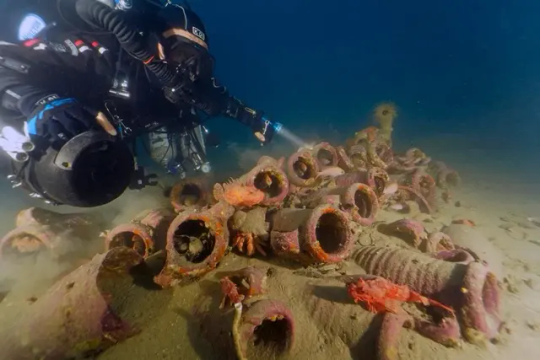
Rare Roman Pottery Uncovered Beneath Sicilian Waters
The vessels could help elucidate ancient trade routes.
A shipwreck carrying rare Roman pottery has surfaced three miles off the coast of Syracuse, Sicily—among the Vendicari Wildlife Oasis Orientata Nature Reserve. Two fishermen initially noticed strange objects poking up from the seafloor around this area back in January 2022. They promptly reported their discovery to Italian authorities. Now, the Superintendence of the Sea of Sicily has partnered with the Capo Murro Diving Center, directed by Fabio Portella, to take a closer look.
Nearly 230 feet beneath the water’s surface, divers came upon and documented in three-dimensional photogrammetric relief 40 ceramic vessels. Some have since become part of the marine ecosystem, scattered about and half-buried, but most are still lined up in their original, neat cargo rows. The ship which once carried them is buried in the sand beneath, authorities said.
These jugs’ distinctive shape and features match the traits of Richborough 527 jars, a type of horizontally ribbed amphora. Although these vessels are named for the town in Kent County, England, where they were first classified, they have popped up throughout the former Roman Empire—predominantly in Southern Britain, though fragments have also appeared in Spain, Croatia, and beyond.
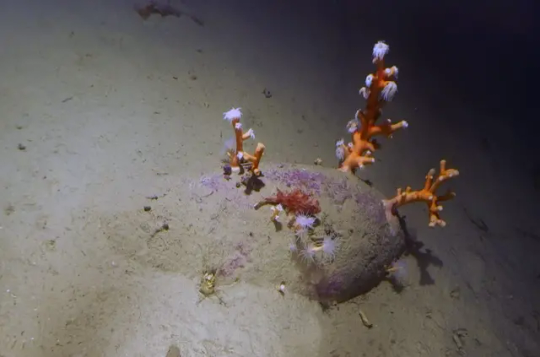
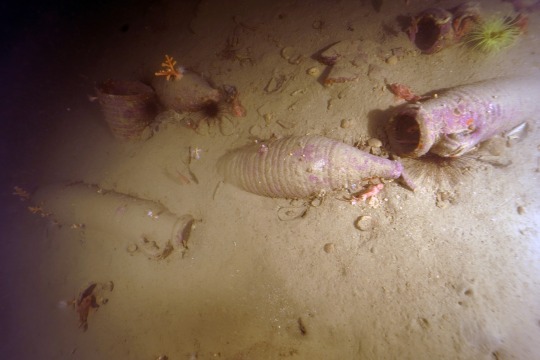
Richborough 527 jars are believed to have originated, however, in Lipari, Italy, one of the Aeolian Islands, situated 25 miles off of Sicily’s northern coast. If it turns out that these vessels are the same variety manufactured and found amongst Lipari, that would render them roughly 1,900 to 2,100 years old.
Similar amphora turned up in Lipari alongside evidence of alum during the 1990s, “during excavations in the Portinenti Valley,” Italian authorities noted. Richborough 527 jars were often used to transport alum, a compound of double-hydrated aluminum and potassium sulfate. The chemical was a known specialist product frequently traded around the Roman Empire. Alum served multiple purposes, but was most often used to affix dye to fabric. What’s more, it ranks amongst the major volcanic products of Lipari, as documented by the likes of famed ancient Greek historian Diodoro Siculo.
Based on their announcement, it doesn’t seem like the Superintendence has any intention of bringing these amphorae ashore—or digging up the rest of the ship itself. Instead, it’s more interested in verifying whether the newly discovered amphorae are actually Richborough 527 jars. If so, finding them over here, off of Sicily’s southern shores, would help historians understand more about ancient Mediterranean trade routes, in a manner that only such lucky underwater finds make possible.
By Vittoria Benzine.

#Rare Roman Pottery Uncovered Beneath Sicilian Waters#Sicily#Richborough 527 jars#amphora#pottery#ancient pottery#shipwreck#ancient artifacts#archeology#archeolgst#history#history news#ancient history#ancient culture#ancient civilizations#roman history#roman empire
23 notes
·
View notes
Text
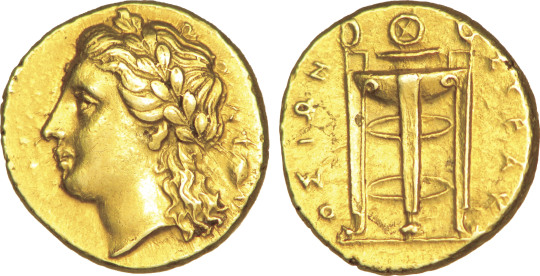
Coin minted from electrum (a naturally occurring gold-silver alloy) by the Sicilian polis of Syracuse between ca. 310 and 305 BCE, when it was under the sway of the expansionist tyrant Agathocles. On the obverse, the head of Apollo, shown with his characteristic long hair; on the reverse, the Delphic tripod, atop which the Pythia sat when delivering oracles. Photo credit: CGB Numismatique Paris.
#classics#tagamemnon#Ancient Greece#Magna Graecia#Sicily#Ancient Sicily#Hellenistic period#ancient history#Greek religion#Ancient Greek religion#Hellenic polytheism#Apollo#God Apollo#art#art history#ancient art#Greek art#Ancient Greek art#Hellenistic art#Sicilian art#coins#ancient coins#electrum#Greek coins#Ancient Greek coins#numismatics#ancient numismatics
172 notes
·
View notes
Text
sooo my brother follows my art tg channel n he asked me if my tg pfp is a don from mafia 2 n i said yes n then he asked me why i draw stuff like in mafia style (<- ok???) n i had to tell him all the cringe and embarassing lore of my drawings & the fan script im making and i think i never was so honest w any family member before .
#ok .#(s)he knows#i told him that ive read a book bout capone n also history of sic mafia n also 20th america n now#im reading sciascia whos a sicilian author who has uh novels or what bout mafia as well#what r u gonna do!!! im a sick person !! ok he didnt judge me
10 notes
·
View notes
Text

Noi fummo i Gattopardi, i Leoni; quelli che ci sostituiranno saranno gli sciacalletti, le iene; e tutti quanti gattopardi, sciacalli e pecore, continueremo a crederci il sale della terra.
Giuseppe Tomasi di Lampedusa, Il Gattopardo (The Leopard)(1958)
We were the Leopards, the Lions; those who'll take our place will be little jackals, hyenas; and the whole lot of us, leopards, jackals, and sheep, we'll all go on thinking ourselves the salt of the earth.
#lampedusa#giuseppe tomasi di lampedusa#il gattopardo#the leopard#quote#novel#literature#film#cinema#movie#nobility#decline and fall#sicily#italian history#aristocracy#sicilian nobility#italy#society#social change#elites#ruling class#modernisation#old order#custom#heritage#arts#culture
61 notes
·
View notes
Text

115 degrees on the rocks today at incredible Valle dei Templi. 🪨🌞🇮🇹
#sicily italy#Sicily#Sicilian#agrigento#valley of the temples#unesco#ancient rome#ancient greece#ancient greek mythology#greek gods#greek architecture#greek art#greek archaeology#archeology#ancient civilizations#art history#roman empire#Roman#zeus#greek mythology#italia#italian#travelgram#travel diaries#travel diary#travel journal#acropolis#parthenon#study abroad#ancient greek
9 notes
·
View notes
Text
Everyone makes a big deal about invading Russia during the winter but no one talks about the Utter Clownery required to invade Sicily literally every time it's happened.
#and by every time i mean the sicilian expedition of 411 BCE and the Allied invasion of Sicily in 1943#operation mincemeat is so funny#and the deherming of the herms?? buffonery#tagamemnon#history#this is just a crossover of my subject areas#classics#ancient history#world war two
14 notes
·
View notes
Text
I find it very ironic that Nora named the Moriyama liability "Riko" when the Rico Act of 1970 virtually destroyed Organized crime in America
#obviously the Sicilian mafia is still alive#they just don't run New York anymore#just some food for thought#all for the game#the foxhole court#the kings men#the raven king#neil josten#andrew minyard#riko moriyama#mafia#history
27 notes
·
View notes
Text
Mafia scar.... Oh mafia scar......
2 notes
·
View notes
Text
I know almost nothing about this subject but this is something that I've been looking for a long time: I found a (historical) Sicilian Rabbi! i don't know why this excites me so much, but it does!
#sicilian#sicily#italy#judaism#jumblr#jewish#jewblr#actually jewish#jew#am yisrael chai#and european history isn't just intercontinental colonization#history#culture#expulsion#15th century#im so excited#so cool#woah#this is so cool
19 notes
·
View notes
Text
Sicily: An Island at the Crossroads of History. Ch. 17- The Second World War
This will be the last chapter in my review/notes of the book.
Germany invaded Poland in 1939. Mussolini declared support for Hitler, but knew Italy wasn't ready to enter the war yet. But in 1940, Mussolini sent over a force to Libya to cross into Egypt and attack the British forces there. Despite being greatly outnumbered, the British held their own.
Mussolini's missteps in Ethiopia, Greece in 1940, and the Balkans had all been disastrous, and by 1943, the Italians had had enough. In July '43, the allies launched an invasion through Sicily. The Americans used a set of Sicilian-American mafiosi to help them navigate the island and make sure their way was cleared.
Churchill was convinced that getting Italy out of the war was the first objective. Sicily became a prime objective. Once the Allies held Sicily, they could establish supply and airbases from which to attack the Nazis.
Both the American general Patton, and the British general Montgomery invaded Sicily jointly. These two men hated each other's guts. The island was supposed to have been defended by 300,000 axis troops, but most were Italians who, fed up with the Fascist regime, had little stomach for the fight by now. They surrendered in droves as the Allied armies encountered them, and the deluge of prisoners ended up causing huge problems.
Mussolini was dismissed in July 1943, then promptly arrested. Italian crowds were jubilant, but on Sicily, the American and English armies were dealing with exhaustion, heat, dengue, sandfly and Malta fevers... and then malaria, which killed over 20 thousand soldiers in the combined armies.
The armies were welcomed in Sicily as a relief from the dictatorship; plus they brought food and drugs to combat malaria. The Mafia had benefited as well from their cooperation with the American intelligence. As a reward, they were appointed to primary positions in the new Sicilian government positions.
In 1944, the Allies handed Sicily back over to the Italian authorities. Italy finally granted Sicily a large degree of autonomy, hoping it would give the Sicilians a new sense of political responsibility. Sicily had its own cabinet of ministers, and near complete control over industry, agriculture and mining, as well as considerable control over public order and communications. Italy also finally recognized Sicily could not continue as the disgrace it had been for so long, and voted it a substantial subsidy. This essentially ended all the separatist talk. The Mafia, on the other hand, continued as it always had.
There is a summary chapter in the book, but I won't bother to recap that since it really adds nothing more to the actual history of Sicily. For my own part, I found myself wishing there were more about Sicily in Sicilian history. But since for nearly all its history, decisions about the island have been made by people ruling from afar, much of Sicily's history is wrapped up in events that don't tell us much about Sicily itself. I am looking forward to several other books on Sicilian history, and maybe there I'll find more about what was happening on the island itself. But it also has to be acknowledged that things that were happening on Sicily were profoundly affected by those external decisions, so any history of what was happening on the island has to reference them.
0 notes
Text
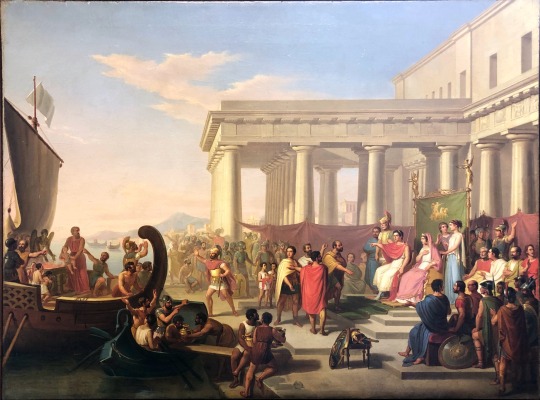
Gelon granting peace terms to the defeated Carthaginians on condition that they give up human sacrifice
by Michele Panebianco
#gelon#art#michele panebianco#syracuse#sicily#carthage#carthaginian#greek#sicilian#sicilian wars#gela#mediterranean#magna graecia#ancient greek#ancient greece#italy#battle of himera#gelo#history#antiquity#europe#european#ancient carthage#punic#phoenician
54 notes
·
View notes
Text
A classic Greek vs Roman situation
#agathocles#greeks vs romans#roman history#greek history#syracuse#sicily#archimedes#greek tyrants#greek tumblr#roman tumblr#italian tumblr#sicilian#king of Sicily#sextus can sext us#sextus pompey#Sextus Pompeius#pompey the great#punic wars#carthage#greece#magna graecia#greater greece#pyrrhus#pyrrhus of epirus#pyrrhic victory#pyrrhic#Pompeius magnus#gnaeus pompey#pompeius#gnaeus pompeius magnus
8 notes
·
View notes
Text
random hc that rantaro is sicilian (on his mother's side) and tans a LOT in the summer. every now and again on his travels he'll get an "are you SUUUURE you're japanese???" bc some people see his double lidded eyes and assume hes lying. it pisses him tf off but its like. what can you do
he also has very strong opinions on sicily vs italy and his nationality
#hes that mf that STRESSES that hes not italian he is specifically sicilian and hes so real for that tbh knowing the history#i just think itd be a good visual parallel to how i characterize him as a person who doesnt seem to fit in anywhere#as someone who looks too european to pass as asian and too asian to pass as european#visually he fits in neither country#to kinda parallel how emotionally he doesnt fit anywhere either
4 notes
·
View notes